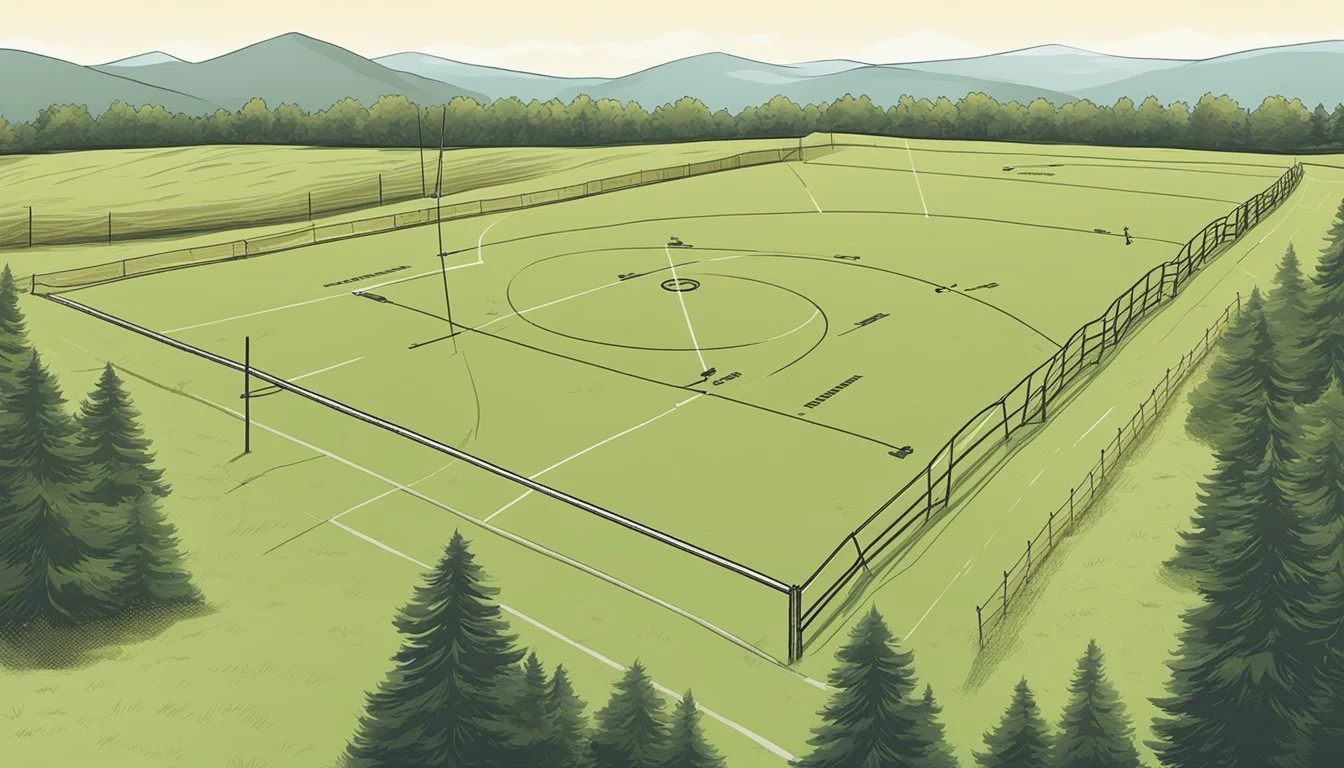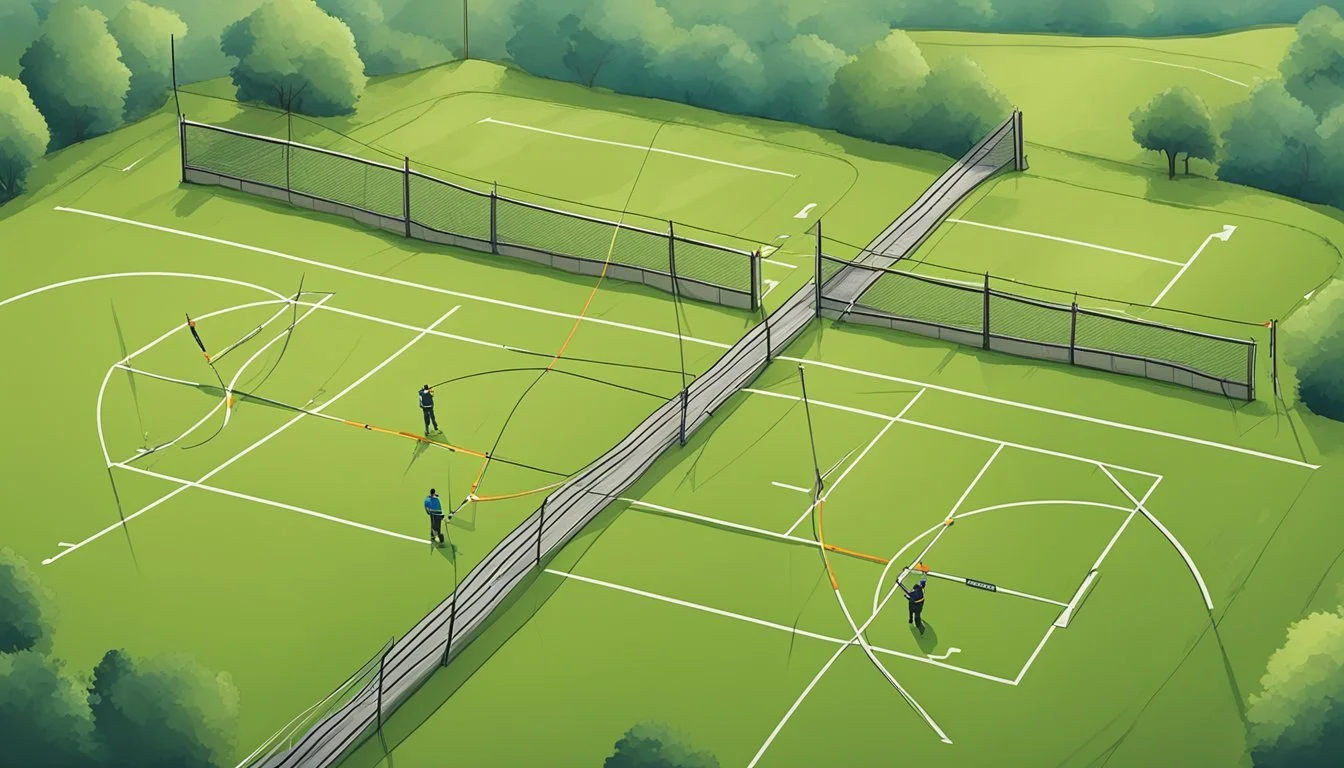Free Land for Archery Ranges
Safe Practice Areas Explained
Finding free land for archery ranges can be an exciting venture for enthusiasts looking to practice in a safe and accessible environment. Whether you're just starting out or have years of experience, securing a designated space for archery practice ensures both safety and adherence to regulations. One practical solution is to use your own backyard, as archery practice is legal in many areas provided certain safety measures are met. Establishing a home range requires clear guidelines and proper equipment to maintain an accident-free zone.
Local archery shops often serve as excellent practice venues, with many offering fully equipped indoor ranges for customers. These shops provide a controlled setting where archers can hone their skills under safe conditions. Engaging with local businesses not only supports small enterprises but also connects you with a community of like-minded individuals.
Parks and community centers sometimes have allocated spaces for archery ranges. These public areas often come with the benefit of professional oversight and established safety protocols. Meeting with park officials to discuss potential spaces can uncover opportunities you might not have considered.
Understanding Archery Ranges
Archery ranges provide designated areas for archers to practice safely and effectively. Different types of ranges cater to various styles of archery, and engaging in this sport offers numerous benefits.
Types of Archery Ranges
Target Archery Ranges: These are typically flat, level fields ideal for precision shooting. Targets are set at specific distances, often measured in yards or meters. This type of range supports both beginners and advanced archers, providing consistent practice conditions.
Field Archery Ranges: These ranges are set in more natural, uneven terrain. They simulate outdoor hunting conditions, with targets placed at varying distances and elevations. This requires archers to adapt their techniques based on the environment.
Indoor Archery Ranges: Useful for year-round practice, these ranges offer controlled settings, crucial for training in adverse weather. These ranges are typically smaller, catering to short-distance shooting.
Backyard Archery Ranges: Suitable for personal use, these ranges demand careful setup to ensure safety. They should have clear rules, proper equipment, and be located away from high traffic areas.
Benefits of Archery
Physical Health: Archery enhances upper body strength, balance, and coordination. Drawing a bow engages multiple muscle groups, promoting physical fitness.
Mental Focus: Precision and accuracy in archery rely heavily on concentration and mental discipline. Regular practice improves focus and enhances cognitive skills.
Stress Relief: The repetitive motion and focus required in archery provide a calming effect, helping to reduce stress.
Social Interaction: Archery ranges serve as community hubs where people of various skill levels come together. This fosters camaraderie and teamwork.
Skill Development: Archery sharpens hand-eye coordination and fine motor skills. Mastering these techniques can also benefit other shooting sports and outdoor activities.
Archers gain valuable skills and experiences, making this both a physically and mentally rewarding sport.
Location and Legality of Free Land
When seeking free land for archery ranges, it's crucial to understand the availability of suitable public lands, how to identify appropriate properties, and the specific legal requirements that must be met.
Public Lands and Archery
Public lands can offer numerous opportunities for setting up archery ranges, provided they meet certain criteria. Each state has different regulations, so consulting a map of local public lands is essential. Many areas allow archery practice if there's no risk to the public and the space is appropriate for shooting activities.
Factors to consider include distance from populated areas, roads, and any other potentially hazardous elements. Often, maintaining a minimum safe distance, such as 150 feet from highways, is necessary. Checking specific rules with local authorities is a wise first step before using public lands.
Identifying Suitable Property
Identifying a suitable property for an archery range involves several key considerations. The property must be large enough to ensure safety during practice, usually requiring an enclosed or clearly demarcated area. Using resources such as local maps or property databases can help find locations that meet these criteria.
Look for areas that are free from obstructions, have minimal foot traffic, and are not close to residential neighborhoods. Make sure that the space allows for safe shooting distances, typically 500 meters from livestock or human activity. This minimizes risks and ensures compliance with standard safety practices.
Legal Requirements and Regulations
Before establishing an archery range, it's necessary to understand and comply with all legal requirements and regulations. This can include obtaining permits, adhering to distance guidelines, and ensuring proper supervision, particularly if minors are involved. Some counties require inspections by ordinance officers to certify the safety of the range.
Regulations also often specify the need for protective measures, such as barriers or backstops, to prevent accidents. It's vital to verify these requirements with local authorities and possibly state wildlife or recreation departments. Ensuring compliance not only promotes safety but also helps avoid legal issues.
Setting Up Safe Archery Practices
Establishing a safe archery range involves following stringent safety protocols, designing an effective backstop, and ensuring proper equipment and shooting safety. Proper setup and maintenance are crucial for minimizing risks.
Safety Protocols for Archery Ranges
Safety protocols are vital in preventing accidents and ensuring that everyone on the range remains secure. Clearly posted range rules such as always walking on the range and keeping arrows in the quiver until ready to shoot are essential.
Instructors should supervise at all times, offering guidance on proper form and reminding archers to check their surroundings before shooting. Additional measures include establishing a clear "ceasefire" signal that everyone understands and agrees upon.
Regular safety drills can be conducted to reinforce these protocols. Emphasis on no running, no horseplay, and maintaining a safe distance from the firing line at all times helps in fostering a disciplined environment.
Designing a Safe Backstop
A safe backstop is a critical component of any archery range. The backstop should be constructed from materials like thick foam, rubber mats, or straw bales to effectively stop arrows without issues.
Proper placement of the backstop is crucial. It should be situated behind the target to catch any stray arrows. The backstop must also be tall and wide enough to cover the area of potential misses.
Additionally, ensuring that the area behind the backstop is free from obstructions such as pathways or buildings helps in preventing accidents. Periodic inspections and maintenance of the backstop will keep it in optimal condition, thus ensuring continued safety.
Equipment and Shooting Safety
Investing in the right equipment is not only about performance but also safety. Using high-quality bows and arrows can prevent breakages that might lead to injuries.
Archers should regularly inspect their equipment for any signs of wear or damage. This includes checking the bowstrings, limbs, and nocks of arrows.
Personal protective equipment such as arm guards and finger tabs should be worn to prevent injuries. Ensuring that everyone on the range follows these protocols while shooting is imperative.
Proper shooting techniques should be instructed and practiced. This includes correct stance, drawing the bow correctly, and focusing on the target. These practices help in achieving accuracy and maintaining safety standards.
Community and Archery Ranges
Archery ranges play a vital role in fostering local communities by offering safe, accessible spaces for practice and socializing. Building a local archery community and collaborating with parks and recreation departments are key to maximizing the benefits of these ranges.
Building a Local Archery Community
Local archery clubs are central to developing a supportive community. These clubs organize events, such as tournaments and workshops, making archery accessible to newcomers and experienced archers alike. By providing structured learning environments, they help individuals enhance their skills.
Family and friends often participate together, strengthening social bonds. Clubs can offer youth programs, encouraging younger generations to pick up the sport. Public shooting events at local ranges make the sport more visible and inclusive, attracting diverse groups.
Regular meetings and social gatherings at archery ranges can foster a sense of belonging. This sense of community can lead to increased participation and support for archery programs, ensuring long-term sustainability.
Collaboration with Parks and Recreation
Partnerships with parks and recreation departments are crucial for maintaining and promoting archery ranges. These collaborations can secure funding and resources necessary to build and maintain high-quality facilities. Parks often have the land and infrastructure needed for safe, accessible practice areas.
Joint events hosted with parks departments can draw larger crowds. These events could range from introduction to archery days, where equipment is provided, to advanced skill workshops. Collaborative initiatives can enhance the visibility of archery, bringing more community members into the sport.
Additionally, parks and recreation departments can assist in promoting these ranges through their established networks. This can include listings in seasonal activity guides, social media announcements, and community bulletin boards, ensuring that local residents are well-informed about available archery opportunities.
Supplementary Facilities and Amenities
When establishing a free land archery range, consideration of supplementary facilities like archery shops and clubs can significantly enhance the experience. Maintenance and upkeep planning ensures the range remains safe and efficient.
Adding Value with Archery Shops and Clubs
Archery shops onsite offer immediate access to equipment and repairs. This convenience attracts archers, especially beginners, who may need guidance on gear choices.
An archery club provides a structured environment for practice and competition. Clubs often organize events and workshops, fostering community engagement. Regularly held events draw larger crowds and can introduce more people to the sport.
Establishing partnerships with archery shops can be beneficial. Offering discounts for club members at these shops can also be an incentive for joining.
Planning for Maintenance and Upkeep
Regular maintenance is crucial for the safety and longevity of the range. Tasks include checking targets, repairing damaged equipment, and ensuring the field remains clear of debris.
A dedicated maintenance crew helps manage these tasks efficiently. Maintenance schedules should be created to address routine inspections and repairs.
An effective maintenance plan also involves budgeting for repairs and replacements. Keeping an inventory of spare parts and tools can minimize downtime.
Incorporating community volunteers for maintenance can reduce costs and build a sense of ownership among users.
Promoting Archery Ranges
Enhancing the visibility and reach of archery ranges involves strategic marketing, community engagement, and leveraging digital tools. It is crucial to convey safety and accessibility to attract a broad audience.
Marketing and Awareness Strategies
Effective marketing campaigns should target local archery clubs, schools, and community centers. Organizing demonstrations and archery clinics can pique interest and provide hands-on experience. Advertising through local media, like newspapers and radio, helps reach different demographics.
Printed materials, such as flyers and posters, should highlight key features such as targets, safety protocols, and range availability. Social media platforms can also amplify outreach efforts by sharing engaging content and updates about events or new programs.
Engaging with Archery Enthusiasts
Building a strong community around the archery range involves regular events and competitions that cater to both beginners and experienced archers. Collaborating with local archery clubs can help create a schedule of events that keeps the community engaged.
Hosting workshops and training sessions can also attract new participants. Feedback from enthusiasts should be encouraged to improve the range and its services. Providing amenities such as comfortable seating areas and refreshment stands can enhance the overall experience.
Utilizing Digital Tools and Maps
Interactive maps are essential for illustrating the layout of the archery range. They should clearly display shooting lanes, target locations, and safety zones. An easy-to-navigate website with an integrated map can help users plan their visits effectively.
Digital tools like online booking systems simplify the process of reserving range time. Social media and email newsletters keep the community informed of any updates or changes. Utilizing geotagging on platforms like Google Maps can make the range more discoverable to potential visitors.
Considerations for Specific Groups
Providing free land for archery ranges can greatly benefit various groups, particularly youth involved in educational programs and hunters seeking safe practice areas.
Youth and Educational Programs
Youth and educational programs benefit immensely from designated archery ranges. Safety is paramount; clearly posted rules and supervised environments foster better learning experiences. Young archers develop discipline and focus, which are integral skills both on and off the range.
Structured lessons should cover basic bow handling, target shooting techniques, and safety protocols. Offering programs through schools and youth organizations enhances accessibility. Keeping equipment age-appropriate ensures that younger participants have a positive and manageable experience, promoting sustained interest in the sport.
Archery for Hunters
Hunters require archery ranges to practice with equipment such as broadheads and different bow types. Realistic setups that mimic hunting conditions help improve accuracy and preparedness. This practice is essential for ethical hunting, ensuring that hunters can make clean and humane shots.
Seasonal adjustments to ranges, like moving targets and different terrain layouts, provide relevant practice scenarios. Also, maintaining signage that clearly indicates rules and safety measures is crucial. These adjustments not only help in honing specific skills but also assure the safety of all users on the range.
Additional Activities and Range Use
Archery ranges can be utilized for a variety of activities beyond just archery practice, including community events and competitions that attract participants and their families. This multi-purpose use makes archery ranges dynamic spaces.
Multipurpose Use of Archery Ranges
Many archery ranges, especially those located at fairgrounds or parks, serve more than one purpose. These spaces can accommodate family-friendly gatherings, picnics, and other outdoor activities.
Some ranges are adapted for seasonal events, such as summer camps where children and teens can learn archery along with other skills. This versatility extends to sharing the area with other shooting ranges like outdoor gun ranges, ensuring that enthusiasts have a place to practice rifle and other forms of shooting safely.
During off-hours, ranges can be repurposed for different community activities. For instance, farmers markets, local festivals, and even exercise classes can take place when the range is not being actively used for archery. This multipurpose use maximizes space utilization and benefits the community by providing a venue for various interests and events.
Hosting Events and Competitions
Archery ranges are ideal for hosting competitions and other archery-related events. These events bring together archers of all skill levels, fostering a sense of community and friendly competition.
Safety is paramount during these events, hence structured protocols from organizations like the ATA are usually followed. Competitions vary from beginner-friendly shoots to advanced tournaments, catering to a diverse group of participants.
Besides, archery ranges often host fundraising events and charity shoots, creating opportunities for the community to support causes while enjoying their hobby. These events can draw large crowds, including family and friends, boosting local engagement.
By accommodating both small events and large-scale tournaments, archery ranges ensure continuous use and community involvement, adding vibrancy and purpose to these recreational spaces.
Safety Precautions and Injury Prevention
Ensuring safety and preventing injuries are critical aspects of maintaining a successful archery range. This involves clear rules, regular equipment checks, and having trained personnel onsite.
First Aid and Emergency Protocols
Immediate response to injuries is essential. Archery ranges should be equipped with well-stocked first aid kits that include bandages, antiseptics, and gauze. In addition, ranges should have a designated first aid officer present during operating hours.
Trained staff should know how to handle common archery injuries, such as minor cuts or bruises from arrow shafts. In more serious cases, like an arrow puncture, emergency protocols must be in place. This includes having an action plan for contacting emergency services and providing relevant information quickly.
Regular training sessions for staff in basic first aid and emergency response can significantly reduce the impact of injuries. Additionally, having clear signage with emergency contact numbers and procedures will help ensure swift action in case of an incident.








